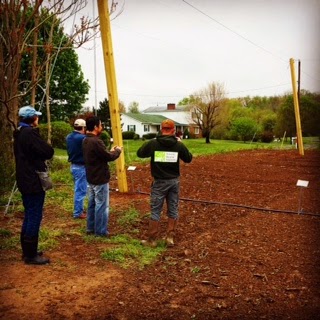 |
| Farm dog Tess hunkered down in the shade. |
When Mary and I went over to the hop yards on Sunday, we took Tess the border collie with us. Tess is a rescue, and she grew up in a rural situation - we've heard they even made a go of turning her into a working dog - but it didn't work out. So far, by having her at the farm, I have learned about some of her stronger instincts: she's very good at finding some shade to hang out in.
Since it was already too hot to do any farm chores, we settled in to getting a count of what plants are up, and then Mary took to training bines. On that first one, there was pretty good news all around - while some of the plants are still just breaking through, we've had 95% success on the rhizomes since planting them on May 2! There's a chart at the end of this post with the results.
We went back over to the hop yards on Monday to see if we could make some progress on hops stringing. This activity has been the bulk of the work at the hop yards since May 9, with several folks putting in time on the effort. We learned a lot from the experience and it's fair to say we have a decent process that we'll get quicker and better at next year.
With about two hours of effort on Monday, Mary and I finished clipping the remaining two rows. David, Eric, and Grayson had finished the stringing activities earlier in the week, so our focus was to set the anchors. After we finished that, we started to train the young bines onto their ropes, and ended our work session by pulling the tails of the ropes out of the drive rows so that David can seed a cover crop in them for the balance of the summer.
 |
| Pano of the strung and clipped acre of hops! |
To close out the post today, I've updated the table below to include the counts and a comparison with the first week, which I counted on May 9. Some of the varieties are at 100%, but I'm pleasantly surprised that we are at 94% and 93% respectively on the CTZ (Columbus) and Goldings - varieties we've been warned may not do so well in the Virginia climate. Now that we're in growing season, we're going keep an eye on the threats we know about, and to steward the whole shebang into fruition later this summer!
 |
| Here is a final count of the plants we got from our rhizome planting on May 2. |





























